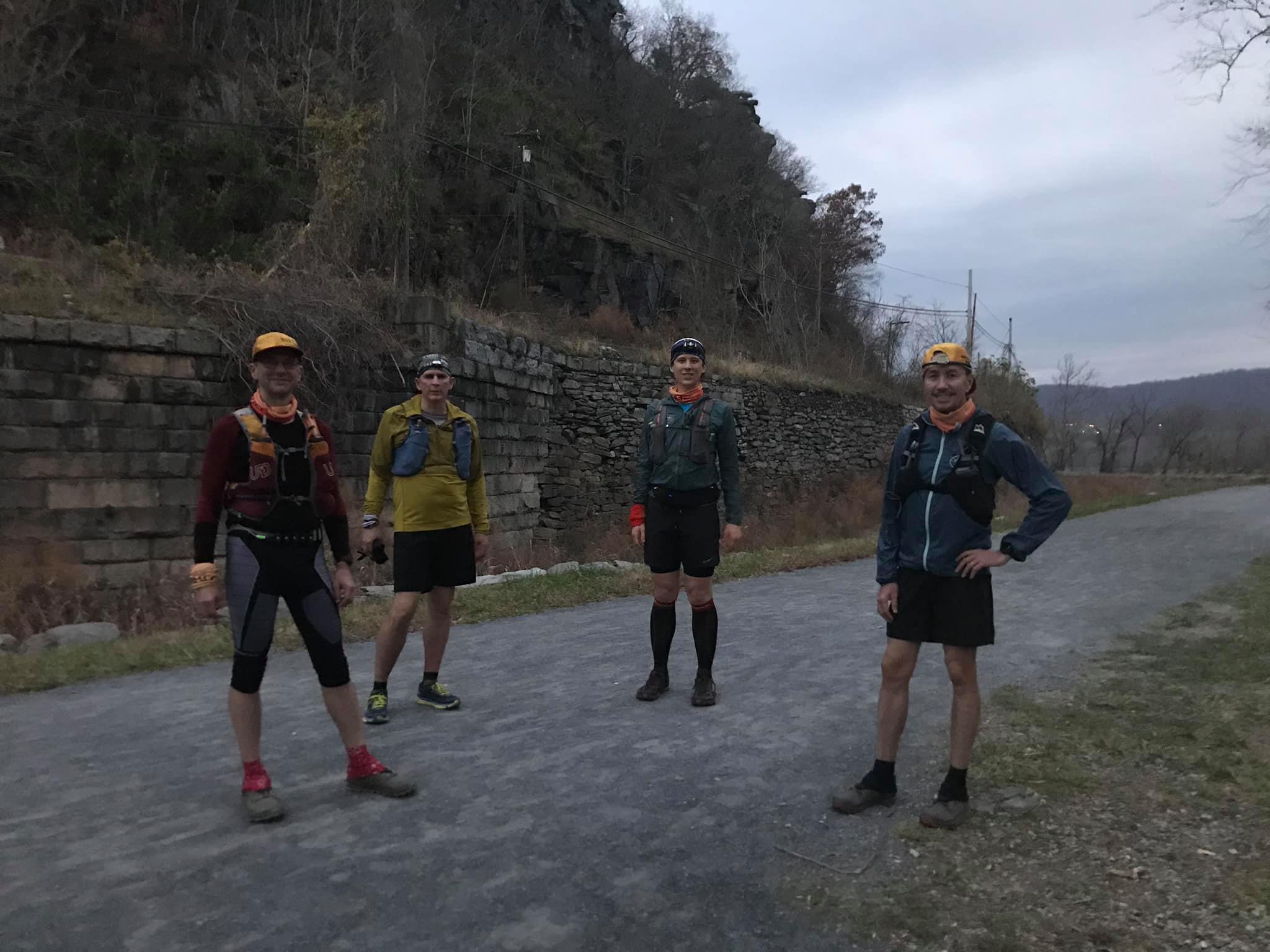Today we share the fun adventure of local runners Paul Encarnacion, Mark Peyton, Jeff Fiolek, and Josh Binder who created the Harpers Ferry (Backyard) 100 . This is a creative and adventurous response to the Covid pandemic which took place Novemember 21–22 2020. Thank you all for answering the questions in the interview!
What’s your challenge and adventure for what is becoming the Covid ultra-marathon?

OK WHOSE IDEA WAS THIS TO DO A BACKYARD 100 MILER ON THE DIFFICULT COURSE THAT YOU DESIGNED?
Paul: It was Jeff’s idea. We were all signed up for Rim to River 100, but due to Covid-19 risk concerns, we decided to defer that race and do a virtual race locally. It all started with a message from Jeff.
Initially, Jeff was envisioning 10 loops of 10 miles, but I preferred not to do something so repetitive, so I suggested incorporating the 4 major peaks in the area that we always run. I was able to string them together as 5 distinct “loops” forming 50 miles that we would then need to run twice. I mapped out each loop using the Strava route planner. The route distances and elevation gain that the Strava route planner indicated, wound up being pretty accurate. Estimated total elevation gain was 13,344 ft. I then created the route guide with the maps and high level turn sheet instructions. Since we were all familiar with the trails, I didn’t have to get too detailed with the turn sheet.
Link: APPENDIX – COURSE LOOPS AND PROFILE
Mark put together a pace sheet to help plan expectations of where we would be throughout the day and what time we should be able to finish. It was pretty close as we were less that half an hour off the estimate.
Josh: see above from Paul
Jeff: The idea was mine. As Paul said we were all signed up and trained for Rim to River 100 but just personal comfort level was to not travel and race so I wanted to do something with the training.
Mark: It was Jeff’s because, well, it’s always Jeff who comes up with these ideas. The four of us had originally planned to run Rim to River, but we were concerned about running a 100 miler in the current Covid environment without even really knowing what the protocols would be for that race. At first, some of us considered doing the old CAT100 course but knew that it would be a lot to ask anyone to risk their own personal safety in order to crew for us. So Jeff came up with the idea of setting up a campsite within one of our trailers as an aid station. We could run different loops out and back so the same aid station could be used the whole race and we wouldn’t have to rely on anyone else for aid.
Once the idea was agreed upon, Paul took over on course design. He wanted to make sure we included all the peaks of the area into the course so he designed five loops cresting the tops of Bolivar, Loudoun, Maryland Heights, and Weverton. The addition of the Schoolhouse Ridge battlefields was intended to be a nice break from the rest of the climbing and add some variety to the course.
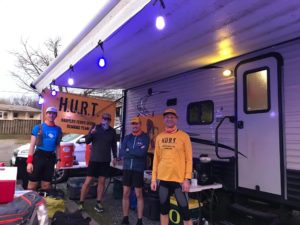
DID EACH OF YOU HAVE A UNIQUE “WHY” ABOUT STARTING THIS?
Paul: My main objective was to have a safer alternative to the Rim to River 100, and be able to still do a 100 miler in 2020.
Josh: I wanted to get a hundred-mile finish!
Jeff: I think it was all the same as above.
Mark: I just needed something that wasn’t work related to focus on in my off time. It has been a pretty stressful year for me with teaching in a virtual environment; stressful to a degree that I’ve not experienced in over twenty years of teaching. Getting out on the trails has been the only relief that I have experienced from that stress, so I wanted more; and I wanted an outlet for that training. I wanted to have something that I could feel good about having achieved during this time.
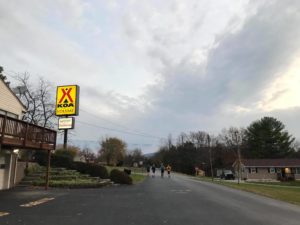
DID ANY OF YOU NEED CONVINCING OR WAS IT A PRETTY QUICK YES?
Paul: I was interested, but just wasn’t sure of the timing, as I wanted to visit my Mom in St Louis for her 92nd birthday (Nov 20), or Thanksgiving. In the end, due to the same COVID-19 concerns, we decided not to go to St Louis after all, and I committed to the run. Mark jumped in even before he had any details of the run. When Josh found out we were doing it, he was all in as well.
Josh: When the idea first came up, I was all in. This was a once-in-a-lifetime chance to run 100-miles around our home trails and experience them in a way that most people don’t get to. It also helped that it was a group effort, so a lot of the stress from a solo run wasn’t there.
Jeff: Originally it was Paul, Mark and I. Then Paul asked Josh if he wanted in and he was a quick Yes.
Mark: It was a quick yes for me. I actually jumped in before I even heard what the proposal was. In all fairness, we all make fun of Jeff for getting us into things; but he usually has pretty solid ideas. I trusted that this would be another one of those. Paul was a little later because he wasn’t sure of the timing. I think Josh was pretty quick too because he was like me and wanted something to run after we all dropped R2R.
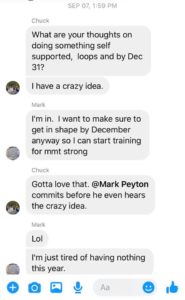
DID YOU SPECIFICALLY TRAIN FOR THIS OR JUST DO IT OFF OF YOUR BASE FITNESS AND LOVE OF TRAIL RUNNING?
Paul: We were training for Rim to River 100, which was just a couple of weeks earlier, so we easily parlayed our training into the HF100.
Josh: No, I built up a base for around 8 weeks, and then had a solid six-week training block where I ran 4 50k’s on the HF trails, and a near 50-mile run (Helltown).
Jeff: Since most of our training is done in and around Harpers Ferry we know the trails very well and love them!!
Mark: I started training for Rim to River , but when we dropped out of that race, the idea of some kind of a self-supported event started floating pretty quickly so I just continued 100 miler training. Once the course was designed, then I decided to insert some more specific training pieces that I thought would help, like the elevation challenge for Rick’s Run this year and Helltown 50 with the four of us.
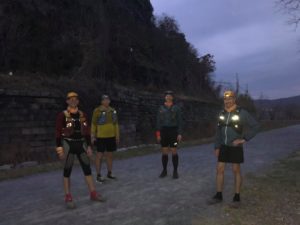
JOSH I UNDERSTAND THIS WAS YOUR FIRST TIME AT THIS DISTANCE. PUAL, MARK JEFF HOW MANY HUNDRED MILER’S HAVE EACH OF YOU DONE?
Paul: Harpers Ferry 100 was my 11th 100-miler.
2013 C&O 100, 2015 HURT 100, 2015 Zion 100, 2015 Oil Creek 100, 2016 HURT 100, 2016 Angeles Crest 100, 2017 MMT 100, 2018 HURT 100, 2019 HURT 100, 2019 No Business 100, 2020 Harpers Ferry 100.
Josh: First hundred finish. . .for now.
Jeff: One reason we chose the Yeti 100 was it was an official event with results and finisher awards and a cut off time, this was more motivating to me than a Fat Ass event.
This was my 6th 100 mile Finish (Oil creek 100 was my first and Two Rivers Treads star James Munnis paced me the last 40 to get the buckle, I think I planted the 100 mile seed/bug in him to finally run Rim to River)
Oil Creek 100 twice, Mohican 100 ,Grindstone 100, No Business 100, Harpers Ferry 100
3 DNF’s too so 6/9
Mark: I have completed three 100 milers – Mohican, No Business, and now HF100. I have DNF’d 2 100 milers, and I include those because I have learned as much from the DNF’s ,that would go on to help me in future races, as I have from the finishes.

TELL ME A LITTLE BIT ABOUT THE LOGISTICS AND SETTING UP THE COURSE AND AID STATION AND WHAT YOU HAD THERE FOR REFRESHMENTS?
Paul: Mark booked a camper site for Friday night through Monday morning. Jeff and I helped him set it up on Friday. We set up the rice cooker and slow cooker and coffee pot, and put the various coolers in place, along with the 5 gallon jugs for water and the energy drink. We also put up the HURT banner and the lights for the awning for the nighttime.
Josh: The course was mapped to hit all the major trail sections (Stone Fort/Md Heights, Loudoun Heights, and Weverton), as well as the battlefields and HF Loop. The aid station was at KOA where Mark had his camper (this also acted as our home base for the end of each loop). For refreshments, we each brought different things which included Coke, Gatorade, chips, cookies, etc. We also had our individual nutrition plans, which for me included Spring Energy gels, Cliff Block chews, Stroopwafels, and a mix of Tailwind, Coke, and Gatorade. Each loop, I would grab a sandwich bag that had around 400-600 calories inside, and that would be my primary nutrition on the run.
Jeff: Having Mark’s camper as start, finish and our aid station was HUGE. Very convenient to access the trailer, hot food, restroom and our drop bags. Way nicer to travel so light in a 100 with all our gear available every 8 to 13 miles. We had hot Tacos, Pizza, Pulled pork and Ginger Rice soup during the cold night. We each brought community aid plus whatever special, personal things we needed.
Mark: We used my trailer to camp at the Harpers Ferry KOA. We set up an aid station in front with all the food, drinks, cooking appliances, and personal gear. Paul, Jeff, and I are pretty experienced at working together to set up an aid station for an event like this since we have running Keep Tryst aid station at C&O100 for the past several years, so everything went up pretty quickly and smoothly.
We had a kitchen area, where we could cook things during the race. Since we wouldn’t be there to monitor the cooking and weren’t using crew, we relied on things like slow cookers and a programmable coffee maker. Paul had his ginger rice soup in his slow cooker (this is an essential part of any 100 because the ginger keeps you eating late in the race when you would normally start getting sick), and I had pulled pork in my slow cooker.
We had a drink area with soda, water, Gatorade, and electrolyte mix (Sword), and we had a snack area with all the normal fares that are found in 100 milers – a little of sweet and a little of salty treats.
Finally, we had a gear area set up with our drop backs so we could easily access them without having to go into the trailer.
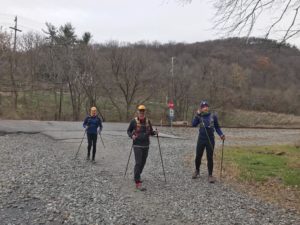
DID ANYTHING SURPRISE YOU OUT THERE?
Paul: Haha, a couple of things come to mind!
In the middle of the night as we were returning for the second time from Loudoun Heights, Jeff was in the lead and as we climbed a short hill, he interrupted a buck mounting a doe, with a second doe looking on. Once the deer saw us, they broke off and scampered away.
Later on that same loop, as we approached Shenandoah St crossing the 340 bridge, we could hear some shouting near the parking lot. This was around 2 am. As we approached the lot, we found a homeless man with a trash bin making the noise. He was talking about spirits wanting to kill him, and then when he saw Jeff, who was wearing a Kogalla Ra waist lamp with no headlamp, he said that he thought Jeff was a midget from the Joker ( whatever that means!) He kept rambling on but we just ignored him and continued on our way back to the campground.
Also, Mark was hallucinating, and maybe Josh too. They’ll need to describe them.
Josh: The leaves had fallen off the trees in the previous weeks and during the first morning, I saw things on the trails that I hadn’t seen before. Mostly involving lines of sight to the river and such, but it was nice to see the ground in a new light, so to speak.
Jeff: It was harder than expected without other racers and aid station people. Plus no spectators was different too.
Mark: What surprised me was how tough the course was when stringing it together into a hundred miles. The whole time going into the race, I was very confident because it’s our backyard and we know it so well. I knew that we would know exactly how to run it, when to push, and when to hold back. Unfortunately, knowing the course so well has its drawbacks too. When you are really hurting, you know exactly what is in front of you. When it felt like it took us all day to make the one mile hike from Harpers Ferry to the 340 bridge, I was feeling pretty low because I knew how much more we had in front of us to get to Weverton cliffs and back to the KOA.
DID YOU KEEP MOVING FOR THE WHOLE 34 HOURS OR DID YOU TAKE A SIGNIFICANT BREAK AT ANY POINT?
Paul: We kept moving the whole time other than 10-15 minute stops at the campground to eat, replenish fluids and nutrition, and prepare any hot food for the next visit. I made some hot ginger-chicken-rice porridge, and Mark heated up some pulled pork in a slow cooker. Everybody also had their own stashes of food to choose from. I also had a few Hawaiian rolls with guacamole and hummus washed down with cold Coke. Late in the run, Betina (Mark’s wife) brought us some pizza, which was really good.
Josh: The longest break we took was right after mile 70. We had just gotten back from Stone Fort and I decided to do a full gear change, eating break, etc. Probably took around a half-hour, but it set us up for the last thirty miles.
Jeff: Kept moving, no big breaks but Aid station transition times were longer than a normal 100 when we had to make sure we were all ready to head back out. Probably 10-20 minutes each aid station and longer during the night with wardrobe changes and more hot food.
Mark: I think our breaks were always between 15 and 20 minutes but I don’t really know. Once we started getting late into the race, time lost relevance for me as long as we were ahead of the cut pace. I made a pacing chart that had us finishing two hours ahead of the cut, so that was really the only time I paid attention too. There were no intentional extended breaks. Breaks only served to gear up, eat, and drink.
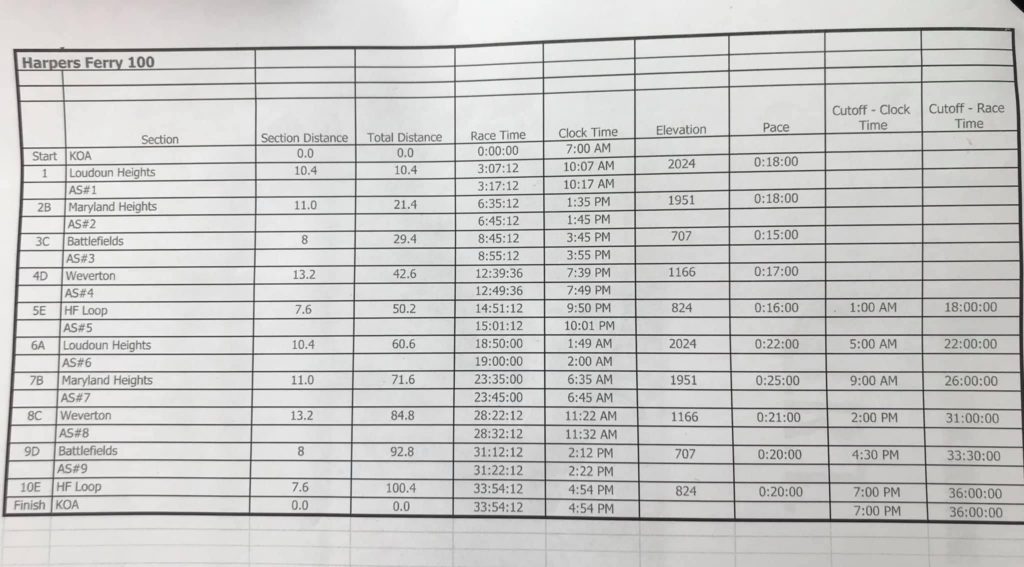
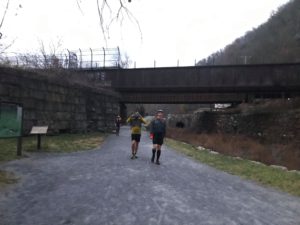
100 MILES IS A LONG WAY. LOOKS LIKE YOU ALL STAYED TOGETHER. WAS THAT THE PLAN OR DID IT JUST KIND OF TURN OUT THAT WAY?
Paul: We did make a plan to stick together for as long as it did not jeopardize our ability to finish under 36 hours. We felt it would be more fun, and safer that way. We weren’t out to race the course so it did not matter if anyone was running slower than they were capable of doing. Jeff can let you know how at about 60 miles, he determined that he needed to modify his course in order to complete his distance, and allow us to finish our course in the time allowed.
Josh: The plan was to stick together, and it ended up working out (for the most part).
Jeff: The plan was to stay together for safety and morale. We stayed together the first 60 miles but then I did an alternate course ( skipping the 2nd climbs on Maryland Heights and Weberton Cliffs) due to aggravating my knee injury. I did shorter loops closer to the Camper but still got 100.7 miles.( I was slowing them down too on climbs they would wait at the top for me and those minutes add up I did not want them to DNF from waiting for me.)
Mark: The plan was always to stay together. We didn’t run it like a race for anyone. We all just wanted to get out, enjoy the experience on our own terrain, and get it finished.
DID YOU ALL GET ALONG OR AT SOME POINT DID ANY IF YOU GET ON EACH OTHER’S NERVES? WHO WAS THE GRUMPIEST AND WHO WAS THE MOST OPTIMISTIC OF THE GROUP?
Paul: I don’t think there was any grumpiness. People would just go quiet if they were in a dark spot, or push ahead a little bit to have some solo time. But we would all catch up to each other, or wait at significant turn points.
Josh: I don’t think we got on each other’s nerves (at least we didn’t vocalize it). I tried to maintain the optimism but sometimes it was difficult (especially after 12+ hours of darkness).
Jeff: We all got along really well, we trained together and even did a 50 mile unsupported run from Front Royal VA to Harper Ferry WV. That was tough carrying all our food and gear the entire 50 miles only refilling our water with filters at streams/springs.
Mark: Everyone stayed mostly positive and friendly the whole time. We all got silent during our low points and just kept it to ourselves. Sometimes if one of us was up during another’s low, there was some encouragement given. There was one time, around mile 90, where I did get pretty irritable and snapped at Josh for dragging his poles on the ground while we were walking along a road. That was the only time that happened to me; but for some reason, it just felt like nails on a chalkboard at that moment.
ANY SIGNIFICANT BAD PATCHES WHERE YOU FELT LIKE SITTING ON A LOG AND NOT GOING ON ANYMORE? IF SO WHAT GOT YOU BACK IN THE RIGHT STATE OF MIND?
Paul: I did not, although on the second visit of Schoolhouse Ridge North, as I ascended the first hill that crosses a wide meadow, it was daylight on the second day, and it all looked so pretty that I just laid down on the grass spreading my arms and legs, and looking up at the sky to take it in for a few moments. It was invigorating.
Josh: I never wanted to not continue, because that was never an option. I had a goal, and I wanted to finish. But it wasn’t easy! Of course, bad thoughts, doubts, and so on, came up over the course of the run, but eating, hydrating, and self-pep talks seemed to do the trick.
Jeff: Mine was miles 60-70 as soon as I was alone, I was sleep walking with my eyes closed near Rt 340 at 4 am ish and the light turned Green and woke me up, DONT TELL MY WIFE!
My WHY was thinking of my mom fighting her battle vs cancer (she lost her battle May 19) and if she can deal with that sh!t I can sure as heck run a few miles.
Plus I had HF100 custom buckles made with Paul’s Logo and no way I was not going to earn one of those bad boys!!
Mark: The section out to Weverton and back was my lowest point. The turn-around was around 76, so that was all in the 70s. I drank four cups of coffee at the aid station before leaving, and then took two caffeine tablets, but just couldn’t wake up. I was sleepwalking most of the way out to Weverton, I hallucinated at one point, and just didn’t feel like going on. Having the others around helped. I don’t know if I could have made it through if I’d been by myself like Jeff was at that point. I decided to eat some peanut butter M&Ms that I had in my pocket, and then I woke up. That was when I realized that it probably wasn’t caffeine that I needed but calories. I told Paul to eat something too because he was feeling the same way. We both seemed to be able to pick up the pace after that. When I got back to the aid station, I had some of the pulled pork that I had put on, and that got me through the rest of the race.

ANY LESSONS LEARNED FOR RUNNERS WANTING TO ATTEMPT 100 MILES?
Paul: A large part of it is mental, so you really need to want it, and know that it will hurt, which is normal and part of the experience. You also need to understand that a large part of “running” 100 miles, at least for our level of capability, is doing a lot of fast walking, so it’s important to practice that in training as well. You also learn to do quick basic math to figure out how many more hours you need to go to finish the distance at the pace you are moving!
Josh: It comes down to being mentally prepared for such a-long effort. You can be the fittest person in the world, but if you can’t push through the dark moments, and keep going, then you’ll have a rough run. I’ve had my share of challenging moments, but learning how to work through them is crucial.
Jeff: Best advice I ever got was from Gary Knipling who has finished MMT 100 something like 17 times, and I told Josh this at some point in the night, is “How are you gonna feel on Tuesday? You know you are gonna feel like crap on Monday whether you finish or not, but how will you feel Tuesday if you Quit?”
100 miles is a loooong way, break it down Aid station to Aid station, finish each section and start again.
Beware the chair, sit down near a warm fire and you might not get back up.
Mark: As I said earlier, I have learned something significant from every race I’ve run. The lesson I learned in this one was the importance of late mileage nutrition. I have been having trouble with the sleepiness factor for a while now and couldn’t figure out what I needed to do differently. When I learned that it could be due to a lack of nutrition and not necessarily caffeine, I realized that in those late miles, I always start drinking coffee for the caffeine. I drink black coffee, so there are no calories being consumed with that. I drink so much of it that I usually don’t feel like eating either, so I think that is what part of my problem has been. Obviously, you are always going to be tired, but anything to give yourself just a little more of an edge can help push through to the end.
Link- interesting read on the mind and ultrarunning
ANY SPECIFIC GEAR, NUTRITION, OR HYDRATION TIPS FOR ULTRA NEWBIES?
Paul: You really need a good handle on your lights for the night portion, especially at this time of year, when we have 14 hours of darkness. you need to know how many spare batteries you need for each lamp and how long each will last at the illumination level you plan to use. A key part of prepping for the race is the 50 mile night run 3 weeks prior that we use as a gear check and final endurance training run. For that, we ran unsupported along the AT from Front Royal, VA to Keys Gap, WV.
For fluid for the 100, I had two 600 ml. soft flasks – one with an energy drink, and the other with just water. I normally use Tailwind for Energy, but Mark had Sword in the 5 gallon jug, so, we just used that. For each loop, I had a 250 calorie Spring Energy Speednut Gel. And every other loop, I would also take a Vespa Jr packet. All these were procured from TRT.
Josh: Nutrition and hydration are highly personal, so I would recommend trying a bunch of different things and finding what works for you. Also, keep in mind, that sometimes (for whatever reason) what has worked in the past won’t work during the race, so be willing and prepared to improvise and change whatever plan you had going into the race (if it isn’t working).
For a hundred, the best piece of gear you can get is a quality light. Nothing is worse than running at night with a headlamp or waist lamp that doesn’t illuminate the trail well. Also, make sure you have a backup light (just in case something happens).
Jeff: Drink and eat before you need to. We are each an experiment of one. What works for Pros might not work for you. Don’t try something new race day, like shoes or socks you have never tried before.
Listen to your body, it will tell you what you need.
At No Business a late AS had Chili, I would never try that in a race, but my body said EAT!! It was awesome.
Coke is rocket fuel!
Mark: I just think you have to spend a lot of time on the trails, in a variety of conditions and times of day. Experiment with different gear, nutrition and figure out what you like. I think it is important to like whatever you are using because there are so few moments of pleasure as you get late into one of the kinds of races, so those little pleasures that might be obtained by a pack of peanut butter M&Ms or a package of Smarties can really help with the state of mind.
THE CREW IS ALWAYS SUPER HELPFUL IN EVENTS LIKE THIS. DID YOU HAVE ANY FAMILY OR FRIENDS ASSIST ALONG THE WAY WITH COOKING MEALS OR COFFEE AT THE AID STATION ETC.?
Paul: Telly (Paul’s wife) came out to a few points on the trail to cheer us on and provide a good moral boost, with the HURT cowbell. Betina came to the campsite with pizza, which really hit the spot. On Sunday, our wives, and Cheryl Hennigan as well as Alex Papadopolous came over the campsite to see us on the final loops. But other than that, we had a self-managed aid station at the camper to minimize COVID-19 risk.
Josh: I wanted to do this event as minimal and self-sufficient as possible, so I didn’t have a crew. Good practice for future races, adventures, etc.
Jeff: My amazing wife Sheri always supports me in these crazy things, she believes in my and encourages me no matter what. I remember the first 5k we ran together and how she patiently waited for me walking the hills and now I have 6 100 mile finishes.
My kids tell me “Have fun and do your best!” That is what I can control not weather, not terrain but I can control My attitude and My effort
Telly , Betina , Cheryl H and my wife were our crew, cooking, cowbell, kid watching, shuttling people around they were awesome!!!!
Mark: We didn’t plan on having any crew, but we did have each of our spouses come out at different points during the day. They each brought something special that helped lift our spirits. Sheri brought tacos, Betina brought Five Guys fries and pizza. Telly brought the cheer squad complete with cowbells at different points during the race. It’s always nice to hear the cowbell in the distance.
ANY OTHER THOUGHTS?
Paul: It was great fun, and very special because we consider these our backyard trails and to design a 100 mile course on them was something we had always wanted to do.
We planned which loops to run at particular times of day to minimize contact with tourists and with the pack of runners doing the JFK50, which was running on the same Saturday that we started our run. We were pretty successful in this regard.
I was tasked to name the run and create stickers for it. I felt I could do no better than to name it simply the Harpers Ferry 100. I designed a sticker that displayed the route, with the label HARPERS FERRY 100 MILE. That was suppose to be it, in addition to the buckle we were getting from the Yeti 100 Mile Challenge (virtual run) that we had signed up for. But Jeff felt that the HF100 was rather special and he wanted more distinct buckles for the event, so he surprised us by having a set made, and luckily, we all finished in order to claim those bespoke buckles.
Josh: This event was a lot of fun, and an experience that I’ll remember for the rest of my life. Not everyone is lucky enough to do these things, so I’m grateful to be in a position to take advantage of it. The icing on the cake was doing it with such great people, and experiencing the highs and lows of such a difficult event, as a group, and getting that finish. Go Hurt!
Jeff: Glad to have our HURT crew. HURT has been an amazing group of people
Humor: After the race Josh got picked up right away he said he had an early class Monday, so we had Grandpa Paul, Mark and I have teenage kids and here is the rookie 21 year old who has an early college class. Or the Mentally challenge guy at 2am in the Kayak lot taking about some weird stuff.
Thanks to TRT, they have been on this journey from the tiny upstairs store in Shep town to today. Appreciate your support, knowledge and community spirit!!
Mark: This sport is supposed to be fun, so if you’re not having fun, there isn’t any point. I love being in the woods. The longer the race, the more time I have to be in the woods. This race was tough, and there were definitely points where it sucked, but overall; I had fun. It always feels good to get the buckle, but the race was fun beyond just crossing the finish line. I told Josh that the last 30+ miles are going to suck no matter what, but you have 60-70 miles that can be quite enjoyable so take the time to enjoy them rather than looking for the finish line. It’s about the journey-not the finish.

………………..
Many thanks Paul, Josh, Jeff , and Mark for sharing your adventure!
Dr. Mark

